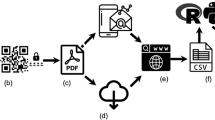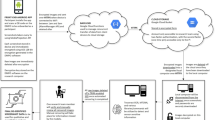Abstract
Examining several sources of data on smartphone use, this paper presents evidence for the popular conjecture that mobile devices are “habit-forming.” The form of habits we identified is called a checking habit: brief, repetitive inspection of dynamic content quickly accessible on the device. We describe findings on kinds and frequencies of checking behaviors in three studies. We found that checking habits occasionally spur users to do other things with the device and may increase usage overall. Data from a controlled field experiment show that checking behaviors emerge and are reinforced by informational “rewards” that are very quickly accessible. Qualitative data suggest that although repetitive habitual use is frequent, it is experienced more as an annoyance than an addiction. We conclude that supporting habit-formation is an opportunity for making smartphones more “personal” and “pervasive.”




Similar content being viewed by others
Notes
Different temporal thresholds were used for the laptop and smartphone data. The thresholds (29 s session duration for the laptop data and 24 s for smartphone data) were chosen because they are the median 20th percentile session durations in the respective data sets. Equivalent results were achieved with other threshold values.
References
Charng HW, Piliavin JA, Callero PL (1988) Role identity and reasoned action in the prediction of repeated behavior. Soc Psychol Q 51(4):303–317
Fogg B, Hreha J (2010) Behavior wizard: a method for matching target behaviors with solutions. In: Proceedings of persuasive 2010, pp 117–131
Fogg B (2003) Persuasive technology. Morgan Kaufmann
James W (1890) The principles of psychology, vol 1 & 2. Holt, New York
LaRose R, Lin CA, Eastin MS (2003) Unregulated internet usage: addiction, habit, or deficient self-regulation? Media Psychol 5(3):225–253
Kahneman D, Krueger AB, Schkade DA, Schwarz N, Stone AA (2004) A survey method for characterizing daily life experience: the day reconstruction method. Science 306(5702):1776
Klasnja P, Consolvo S, McDonal D, Landay J, Pratt W (2009) Using mobile and personal sensing technologies to support health behavior change in everyday life: lessons learned. Annual Conference of the American Medical Informatics Association, pp 338–342
Lowry D, Moskos M (2005) Hanging on the mobile phone: experiencing work and spatial flexibility. In: Unpublished paper presented as critical management studies conference (Flexibility Stream), Cambridge
Marlatt GA, Baer JS, Donovan DM, Kivlahan DR (1988) Addictive behaviors: etiology and treatment. Annu Rev Psychol 39(1):223–252
Morsella E, Bargh JA, Gollwitzer PM (eds) (2008) Oxford handbook of human action. Oxford University Press, Oxford
Oulasvirta A, Tamminen S, Roto V, Kuorelahti J (2005) Interaction in 4-second bursts: the fragmented nature of attentional resources in mobile HCI. In: Proceedings of the SIGCHI conference on human factors in computing systems, pp 928–937
Oulasvirta A, Petit R, Raento M, Tiitta S (2007) Interpreting and acting on mobile awareness cues. Hum Comput Interact 22(1):97–135
Pantzar M (2010) Future shock: discussing the changing temporal architecture of daily life. J Future Stud 14(4):1–22
Partridge K, Golle P (2008) On using existing time-use study data for ubiquitous computing applications. In: Proceedings of the 10th international conference on Ubiquitous computing, pp 144–153
Patel S, Kientz J, Hayes G, Bhat S, Abowd G (2006) Farther than you may think: an empirical investigation of the proximity of users to their mobile phones. UbiComp 2006, pp 123–140
Raento M, Oulasvirta A, Petit R, Toivonen H (2005) ContextPhone: a prototyping platform for context-aware mobile applications. IEEE pervasive computing, pp 51–59
Rattenbury T, Nafus D, Anderson K (2008) Plastic: a metaphor for integrated technologies. In: Proceedings of Ubicomp
Towers I, Duxbury L, Thomas J (2006) Time thieves and space invaders: technology, work and the organisation. Management 19(5):593–618
Verkasalo H (2009) Contextual patterns in mobile service usage. Pers Ubiquit Comput 13(5):331–342
Walsh SP, White KM (2007) Me, my mobile, and I: the role of self-and prototypical identity influences in the prediction of mobile phone behavior. J Appl Soc Psychol 37(10):2405–2434
Wood W, Neal DT (2007) A new look at habits and the habit-goal interface. Psychol Rev 114(4):843–863
Author information
Authors and Affiliations
Corresponding author
Rights and permissions
About this article
Cite this article
Oulasvirta, A., Rattenbury, T., Ma, L. et al. Habits make smartphone use more pervasive. Pers Ubiquit Comput 16, 105–114 (2012). https://doi.org/10.1007/s00779-011-0412-2
Received:
Accepted:
Published:
Issue Date:
DOI: https://doi.org/10.1007/s00779-011-0412-2




